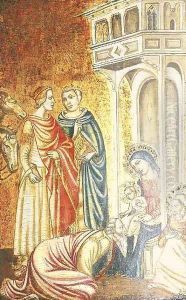Riminese School Paintings
The Riminese School refers not to a single artist but to a group of painters from the 14th and 15th centuries who were active in Rimini, a city in the Emilia-Romagna region of Italy. This school played a significant role in the development of Italian Renaissance art, bridging the transition from the medieval Gothic style to the early Renaissance. The school is particularly noted for its innovative use of color and light, as well as its incorporation of realistic human figures and landscapes, which marked a departure from the more stylized figures of earlier periods.
Key figures associated with the Riminese School include Giuliano da Rimini and Giovanni da Rimini, although it's important to note that historical documentation from this era is sparse, and attributions of specific works to individual artists can be challenging. These artists are known for their detailed altar pieces, frescoes, and panel paintings, many of which depict religious themes with a new level of emotional depth and realism.
The Riminese School was influenced by the work of Giotto, whose frescoes in Padua had a profound impact on the direction of Italian art. However, the Riminese artists developed their own distinctive style, characterized by graceful figures, a rich palette, and intricate landscapes. Their work demonstrates an early exploration of perspective, a technique that would later become a hallmark of Renaissance art.
Despite its contributions to the evolution of Italian art, the Riminese School was eventually overshadowed by the more dominant schools of Florence and Siena, which became the main centers of Renaissance art. Nevertheless, the works produced by the Riminese School during the 14th and 15th centuries remain an important part of Italy's artistic heritage, offering insight into the regional variations in style and technique that characterized the early Renaissance period.
